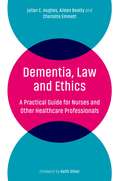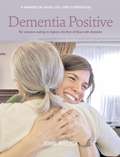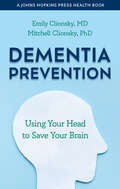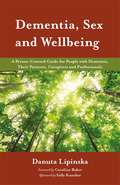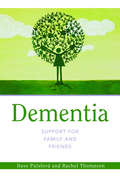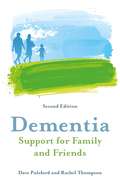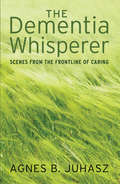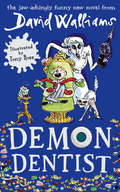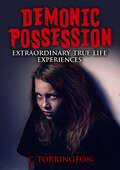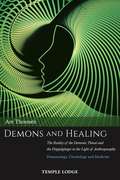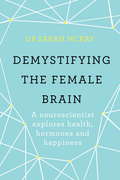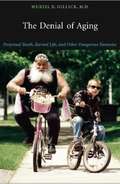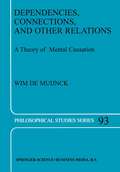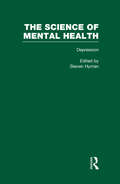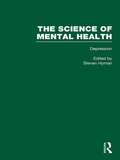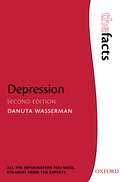- Table View
- List View
Dementia, Law and Ethics: A Practical Guide for Nurses and Other Healthcare Professionals
by Julian C. Hughes Aileen Beatty Charlotte EmmettClinical dilemmas in dementia contexts are often not because the clinical facts are in doubt, but because the ethical and legal underpinnings are uncertain - which can cause worry and confusion. This practical book will help nurses, healthcare assistants and other practitioners to think through their responses clearly in the midst of these difficultsituations.The chapters all stand alone, allowing the reader to dip quickly in and out of the book as required. They address complex issues such as abuse, behaviour that challenges, forced care, treatment withdrawal, and contain clinical case vignettes throughout. This is essential reading to give practitioners the confidence that good legal and ethical decisions can be made in the same way as good clinical decisions.
Dementia, Law and Ethics: A Practical Guide for Nurses and Other Healthcare Professionals
by Julian C. Hughes Aileen Beatty Charlotte EmmettClinical dilemmas in dementia contexts are often not because the clinical facts are in doubt, but because the ethical and legal underpinnings are uncertain - which can cause worry and confusion. This practical book will help nurses, healthcare assistants and other practitioners to think through their responses clearly in the midst of these difficultsituations.The chapters all stand alone, allowing the reader to dip quickly in and out of the book as required. They address complex issues such as abuse, behaviour that challenges, forced care, treatment withdrawal, and contain clinical case vignettes throughout. This is essential reading to give practitioners the confidence that good legal and ethical decisions can be made in the same way as good clinical decisions.
Dementia Positive
by John KillickThis book is not about the past, which has gone. Or the future, which is uncertain. But it is for those who want to improve the lives of people with dementia and themselves in the Here and Now. The book is not written by an expert but by a man seeking to find new approaches concerning dementia who wishes to share his discoveries. Killick steers clear of any sort of medical terminology and instead nurtures the often neglected aspects of dementia, thereby reinforcing to the reader that these are of no lesser importance. In recognition that we are all in this together, Killick gives equal prominence to quotations from, and conversations with, people with dementia and their carers.
Dementia Prevention: Using Your Head to Save Your Brain (A Johns Hopkins Press Health Book)
by Emily Clionsky Mitchell ClionskyWorried about memory loss and dementia risk? This new book will show you easy-to-follow steps to keep your brain healthy.Emily Clionsky, MD, and Mitchell Clionsky, PhD, are a physician and neuropsychologist couple who have cared for their own parents with dementia, created a test used by doctors to measure cognitive function, and treated more than 25,000 patients with cognitive impairment. In Dementia Prevention, they combine the most current scientific findings about Alzheimer's disease and other dementias with their experience to present a practical guide that empowers you to improve your brain's future. This book skips the fads, the unsupported claims of advertised products, and fringe theories. Instead, the authors guide you through a science-based tour of dementia, including how your brain works and how its function is affected by everything from blood circulation and blood pressure to sugar levels, medications, vision, and hearing. You will learn how your activity level, weight, habits, mental outlook, and social engagement may affect your likelihood of developing dementia. Dementia Prevention provides a dementia risk checklist to better understand your personal risk profile to help you on your journey. The authors' training and experience as behavioral scientists will help you set better goals, identify roadblocks to success, and overcome these obstacles. Forgetfulness and confusion are not an inevitable part of growing older—you can make changes to keep your brain working well into your 70s and beyond. From how you breathe while you sleep to what you do socially and physically every day, Dementia Prevention will give you practical—and sometimes surprising—methods for you to protect your brain.
Dementia Prevention: Using Your Head to Save Your Brain (A Johns Hopkins Press Health Book)
by Emily Clionsky Mitchell ClionskyWorried about memory loss and dementia risk? This new book will show you easy-to-follow steps to keep your brain healthy.Emily Clionsky, MD, and Mitchell Clionsky, PhD, are a physician and neuropsychologist couple who have cared for their own parents with dementia, created a test used by doctors to measure cognitive function, and treated more than 25,000 patients with cognitive impairment. In Dementia Prevention, they combine the most current scientific findings about Alzheimer's disease and other dementias with their experience to present a practical guide that empowers you to improve your brain's future. This book skips the fads, the unsupported claims of advertised products, and fringe theories. Instead, the authors guide you through a science-based tour of dementia, including how your brain works and how its function is affected by everything from blood circulation and blood pressure to sugar levels, medications, vision, and hearing. You will learn how your activity level, weight, habits, mental outlook, and social engagement may affect your likelihood of developing dementia. Dementia Prevention provides a dementia risk checklist to better understand your personal risk profile to help you on your journey. The authors' training and experience as behavioral scientists will help you set better goals, identify roadblocks to success, and overcome these obstacles. Forgetfulness and confusion are not an inevitable part of growing older—you can make changes to keep your brain working well into your 70s and beyond. From how you breathe while you sleep to what you do socially and physically every day, Dementia Prevention will give you practical—and sometimes surprising—methods for you to protect your brain.
Dementia, Sex and Wellbeing: A Person-Centred Guide for People with Dementia, Their Partners, Caregivers and Professionals
by Danuta Lipinska Caroline Baker Sally KnockerDespite being integral parts of all our identities, sexuality, sex and intimacy are what many would call the Last Taboo in dementia care, usually seen as 'problem behaviours' to be stopped and dealt with. Informed by a combination of accessible neuroscience and person-centred compassion, Danuta Lipinska's new book shows that the human need for intimacy, attachment and sexual expression is as important for supporting the wellbeing and personhood of people with dementia as communication and care. Considering the brain as the body's biggest sex organ, it examines the cognitive changes that occur in dementia and what these changes mean in the context of sexual behaviour and consent. Taking Carl Rogers' Core Conditions and Tom Kitwood's psychological needs of persons living with dementia as a starting point, Lipinska offers a unique model for person-centred conversations about sex and sexuality that we have not seen before.
Dementia, Sex and Wellbeing: A Person-Centred Guide for People with Dementia, Their Partners, Caregivers and Professionals (PDF)
by Danuta Lipinska Caroline Baker Sally KnockerDespite being integral parts of all our identities, sexuality, sex and intimacy are what many would call the Last Taboo in dementia care, usually seen as 'problem behaviours' to be stopped and dealt with. Informed by a combination of accessible neuroscience and person-centred compassion, Danuta Lipinska's new book shows that the human need for intimacy, attachment and sexual expression is as important for supporting the wellbeing and personhood of people with dementia as communication and care. Considering the brain as the body's biggest sex organ, it examines the cognitive changes that occur in dementia and what these changes mean in the context of sexual behaviour and consent. Taking Carl Rogers' Core Conditions and Tom Kitwood's psychological needs of persons living with dementia as a starting point, Lipinska offers a unique model for person-centred conversations about sex and sexuality that we have not seen before.
Dementia - Support for Family and Friends
by David Pulsford Rachel ThompsonFor friends, family members and carers of people with dementia, understanding the condition and coping with the impact it has on their lives can be extremely challenging. This book, written specifically for these groups, explores each stage of the "journey with dementia" and explains not only how it will affect the person with the condition, but also those around them, and how best to offer support and where to get professional and informal assistance. It focuses on the progressive nature of dementia and the issues that can arise as a result, and gives practical advice that can help to ensure the best possible quality of life both for the person with dementia and the people around them. A comprehensive and practical introduction to the condition, this book is essential reading for anyone who has a friend or relative with dementia.
Dementia - Support for Family and Friends (PDF)
by David Pulsford Rachel ThompsonFor friends, family members and carers of people with dementia, understanding the condition and coping with the impact it has on their lives can be extremely challenging. This book, written specifically for these groups, explores each stage of the "journey with dementia" and explains not only how it will affect the person with the condition, but also those around them, and how best to offer support and where to get professional and informal assistance. It focuses on the progressive nature of dementia and the issues that can arise as a result, and gives practical advice that can help to ensure the best possible quality of life both for the person with dementia and the people around them. A comprehensive and practical introduction to the condition, this book is essential reading for anyone who has a friend or relative with dementia.
Dementia - Support for Family and Friends, Second Edition (Support For Family And Friends Ser.)
by Rachel Thompson Dave PulsfordA comprehensive and practical guide to dementia, this book is essential reading for anyone who has a friend or relative with the condition. This updated edition reflects new guidance on approaches to supporting people with dementia, focussing especially on the UK, and includes quotes from people with dementia as well as from family carers.The book explores each stage of the journey people with dementia face and explains how it affects the person, as well as those around them both at home and in residential settings. It shows how best to offer support and where to get professional and informal assistance. Focussing on the progressive nature of dementia and the issues that can arise as a result, it gives practical advice that can help to ensure the best possible quality of life both for the person with dementia and the people around them.
The Dementia Whisperer: scenes from the frontline of caring
by Agnes JuhaszAgnes Juhasz, writing with great humanity and understanding, draws on many years of working with people with dementia to show how she has learned to communicate and work collaboratively with sufferers and find the essence of the person hiding behind the symptoms of the disease. Based around real-life stories she shows what she has found works and does not work, and candidly reveals her own emotions of frustration, irritation and – sometimes – amusement, and how she has learnt to cope with these. Her honesty in describing the highs and lows of being a carer is an inspiration to all those struggling to find the positive side of an illness we have all come to fear.
Demon Dentist
by David WalliamsThe jaw-achingly funny novel from David Walliams, the number one bestselling author! Make your appointment if you dare…
Demon Lovers: Witchcraft, Sex, and the Crisis of Belief (Chicago Studies In Practices Of Meaning Ser.)
by Walter StephensOn September 20, 1587, Walpurga Hausmännin of Dillingen in southern Germany was burned at the stake as a witch. Although she had confessed to committing a long list of maleficia (deeds of harmful magic), including killing forty—one infants and two mothers in labor, her evil career allegedly began with just one heinous act—sex with a demon. Fornication with demons was a major theme of her trial record, which detailed an almost continuous orgy of sexual excess with her diabolical paramour Federlin "in many divers places, . . . even in the street by night." As Walter Stephens demonstrates in Demon Lovers, it was not Hausmännin or other so-called witches who were obsessive about sex with demons—instead, a number of devout Christians, including trained theologians, displayed an uncanny preoccupation with the topic during the centuries of the "witch craze." Why? To find out, Stephens conducts a detailed investigation of the first and most influential treatises on witchcraft (written between 1430 and 1530), including the infamous Malleus Maleficarum (Hammer of Witches). Far from being credulous fools or mindless misogynists, early writers on witchcraft emerge in Stephens's account as rational but reluctant skeptics, trying desperately to resolve contradictions in Christian thought on God, spirits, and sacraments that had bedeviled theologians for centuries. Proof of the physical existence of demons—for instance, through evidence of their intercourse with mortal witches—would provide strong evidence for the reality of the supernatural, the truth of the Bible, and the existence of God. Early modern witchcraft theory reflected a crisis of belief—a crisis that continues to be expressed today in popular debates over angels, Satanic ritual child abuse, and alien abduction.
Demonic Possession: Extraordinary true life experiences
by C. TorringtonThe idea of people possessed by evil spirits against their will is as old as the hills. Often there is thought to be a special way a person has become possessed. It might be the result of a curse cast on them by a sorcerer, or some unfortunate mishap such as stepping over a dead body. Or the demons can have been invited, in a Satanic ritual. More often, at least in recent Christian tradition, there is no initiating moment that can be identified - they just find their way in, like disease. From Pearl Curran, a housewife living in St Louis, Missouri, who soared to fame in the second decade of the 20th century as the amanuensis of 'Patience Worth', a writer who had died in the 17th century, to victims of Dissociative Personality Disorder (thought to have inspired Dr Jekyll & Mr Hyde), this book examines demonic possession from every angle.
Demons and Healing: The Reality of the Demonic Threat and the Doppelgänger in the Light of Anthroposophy: Demonology, Christology and Medicine
by Are Thoresen‘Genius is a rare commodity that few of us attain. I see the colour-magic painted by Van Gogh, hear the music-magic of Beethoven, imagine touching the exquisite bronze of Rodin’s Thinker. I revere their work but know that I can never create such beauty. So it is with Are’s psychic skills.’ – Phil Rogers, MRCVS, Dublin‘Today we have forgotten all about demons and even about Christ. Both concepts have become anachronisms from olden times. That they are not anachronisms is illustrated in the discussions and examples given in this book.’ – Hans Kolstad, Dr.philos., MAS, NorwayAre Thoresen perceives demons and other spiritual beings as clearly as we see each other. He sees the demons that cause disease as well as the beings associated with medicinal plants and other substances that can promote health. He has witnessed how demons of disease leave the bodies of the sick and enter the healthy, thus causing contagion. Through his therapeutic work, Thoresen has learned that one cannot simply ‘fight’ demons, as they will ‘translocate’ to other people or return later. The only effective way to counteract these malign entities is to dissolve them through the boundless love of the being of Christ.The author presents a lifetime’s knowledge – the fruit of more than half a century’s practical and clinical experience – in the pages of this book, offering a better understanding of health and disease. He recounts numerous personal experiences of demonic entities and explains how demons are created. Thoresen advises on the prevention of the demonic effects of natural and artificial radiation, and how we can defend and ultimately free ourselves from demonic influence. A fascinating Addendum describes the phenomenon of poltergeists and the spiritual beings related to various drugs. Demons and Healing is a singular work, written out of precise vision and knowledge of the spiritual entities that surround us in everyday life.
Demystifying The Female Brain: A neuroscientist explores health, hormones and happiness
by Dr Sarah McKayUnderstanding how your brain works during the key stages of life is essential to maintaining your health. Dr Sarah McKay is a neuroscientist who knows everything worth knowing about women's brains, and shares it in this cutting-edge, essential book.This is not a book about the differences between male and female brains, nor a book using neuroscience to explain gender-specific behaviours, the 'battle of the sexes' or 'Mars-Venus' stereotypes. This is a book about what happens to the brains of women as they cycle through the phases of life, which are unique to females by virtue of their biology and in particular their hormones.In Demystifying The Female Brain, Dr McKay gives insights into brain development during infancy, childhood and the teenage years (including the onset of puberty) and looks at pregnancy, motherhood, and mental health.The book weaves together findings from the research lab, interviews with neuroscientists and other researchers working in the disciplines of neuroendocrinology, brain development, brain health and ageing, along with stories and case studies.
The Denial of Aging: Perpetual Youth, Eternal Life, and Other Dangerous Fantasies
by Muriel R. GillickYou’ve argued politics with your aunt since high school, but failing eyesight now prevents her from keeping current with the newspaper. Your mother fractured her hip last year and is confined to a wheelchair. Your father has Alzheimer’s and only occasionally recognizes you. Someday, as Muriel Gillick points out in this important yet unsettling book, you too will be old. And no matter what vitamin regimen you’re on now, you will likely one day find yourself sick or frail. How do you prepare? What will you need? With passion and compassion, Gillick chronicles the stories of elders who have struggled with housing options, with medical care decisions, and with finding meaning in life. Skillfully incorporating insights from medicine, health policy, and economics, she lays out action plans for individuals and for communities. In addition to doing all we can to maintain our health, we must vote and organize—for housing choices that consider autonomy as well as safety, for employment that utilizes the skills and wisdom of the elderly, and for better management of disability and chronic disease. Most provocatively, Gillick argues against desperate attempts to cure the incurable. Care should focus on quality of life, not whether it can be prolonged at any cost. “A good old age,” writes Gillick, “is within our grasp.” But we must reach in the right direction.
Denim and prairie skirts (large print)
by RnibThere are two images of women's clothing on this page: a denim skirt on the left and a prairie style skirt on the right. Both skirts have their waistbands at the top and their hems at the bottom. There is a locator dot shown, which will be at the top left of the page when the image is the correct way up. The denim skirt is made from blue cotton denim. It is a knee length garment fitted over the hips. It has two patch pockets on the rear (not shown) with belt loops and slanted pockets like a pair of denim jeans. The prairie skirt is gathered in at the waistband. It is full, slightly flared and comes down to mid-calf length. It is has a flounce (a tier) towards the bottom of the skirt, which is again gathered in. The design is based on the heavily flounced fashions of early western America.
Denim and prairie skirts (UEB contracted)
by RnibThere are two images of women's clothing on this page: a denim skirt on the left and a prairie style skirt on the right. Both skirts have their waistbands at the top and their hems at the bottom. There is a locator dot shown, which will be at the top left of the page when the image is the correct way up. The denim skirt is made from blue cotton denim. It is a knee length garment fitted over the hips. It has two patch pockets on the rear (not shown) with belt loops and slanted pockets like a pair of denim jeans. The prairie skirt is gathered in at the waistband. It is full, slightly flared and comes down to mid-calf length. It is has a flounce (a tier) towards the bottom of the skirt, which is again gathered in. The design is based on the heavily flounced fashions of early western America.
Denim and prairie skirts (UEB uncontracted)
by RnibThere are two images of women's clothing on this page: a denim skirt on the left and a prairie style skirt on the right. Both skirts have their waistbands at the top and their hems at the bottom. There is a locator dot shown, which will be at the top left of the page when the image is the correct way up. The denim skirt is made from blue cotton denim. It is a knee length garment fitted over the hips. It has two patch pockets on the rear (not shown) with belt loops and slanted pockets like a pair of denim jeans. The prairie skirt is gathered in at the waistband. It is full, slightly flared and comes down to mid-calf length. It is has a flounce (a tier) towards the bottom of the skirt, which is again gathered in. The design is based on the heavily flounced fashions of early western America.
Denise's Daily Dozen: The Easy, Every Day Program to Lose Up to 12 Pounds in 2 Weeks
by Denise AustineBook Bonus: Links to Exercises and Trivia Quiz From Denise Austin comes the perfect health book for anyone who wants to live better but just can't seem to find the time. Much more than just another excercise book, Denise's Daily Dozen covers a whole range of health and diet related concepts yet manages it all in a no-stress, time-conscious program of 12's. At it's core, this book contains the minimum daily requirements to keep the reader flexible, strong and trim. Organized simply into seven chapters, which equal the seven days of the week, it covers a full week in daily allotments. Each day will have it's own focus from Monday being "fat burning day" to Sunday's "recharge and rejuvenate."Denise has created a total body program, including a 7-day balanced meal plan that includes healthy recipes, and a workout that encompasses 12 exercises done in 12 minutes each day. Everyone can take just 12 minutes, at whatever time of the day works for them, and turn it over to these simple and fun exercises. Cardio, toning, yoga and breathing exercises...they're all here but in a way the maximizes effect while minimizing time.Beyond a dozen exercises for each day of the week this book will include many other of Denises dozens for each day.
Dependencies, Connections, and Other Relations: A Theory of Mental Causation (Philosophical Studies Series #93)
by Wim de MuijnckThis work covers, in its subsequent parts, ontology, the metaphysics of causation, and the philosophy of mind. It provides a firm theoretical basis for believing that in our all-physical world mental causation is perfectly real, and that it can be understood.
Depression: The Science of Mental Health
by Steven HymanFirst Published in 2002. Routledge is an imprint of Taylor & Francis, an informa company.
Depression: The Science of Mental Health
by Steven E. HymanFirst Published in 2002. Routledge is an imprint of Taylor & Francis, an informa company.
Depression (The Facts)
by Danuta WassermanThe term "depression" covers a wide spectrum of conditions ranging from mild despondency to melancholia, the very deepest form of depression. Natural despondency is not a disease but simply a part of life. Depression, however, is a common psychiatric illness that must be identified and treated in the same manner as other illnesses. Depression: The Facts, Second Edition provides a simple, yet comprehensive overview of depression for sufferers, their friends, and families. It contains case-study descriptions and can serve as a quick-reference for those with a medical background. It succinctly details the signs and symptoms of clinical depression, as well as the process of diagnosis and the different subtypes, including major depression, dysthymia, manic depression disorders, and seasonal affective disorder. The second part of the book covers the current understanding of the causes of depression, based on the scientific evidence. The book concludes with a review of treatment options and practical guidance on self-help in depression, as well as useful advice for family and friends. The main aim of this book is to reach those who need help and want to understand themselves and their condition more, in an easy-to-read format without an excess of medical terminology and statistics that may overwhelm the non-medically trained individual. All concepts have been broken down into bullet-points and sub-headings, to allow easy digestion of the concepts and information. This empowers the reader, and may ultimately prompt someone to seek help and support.
